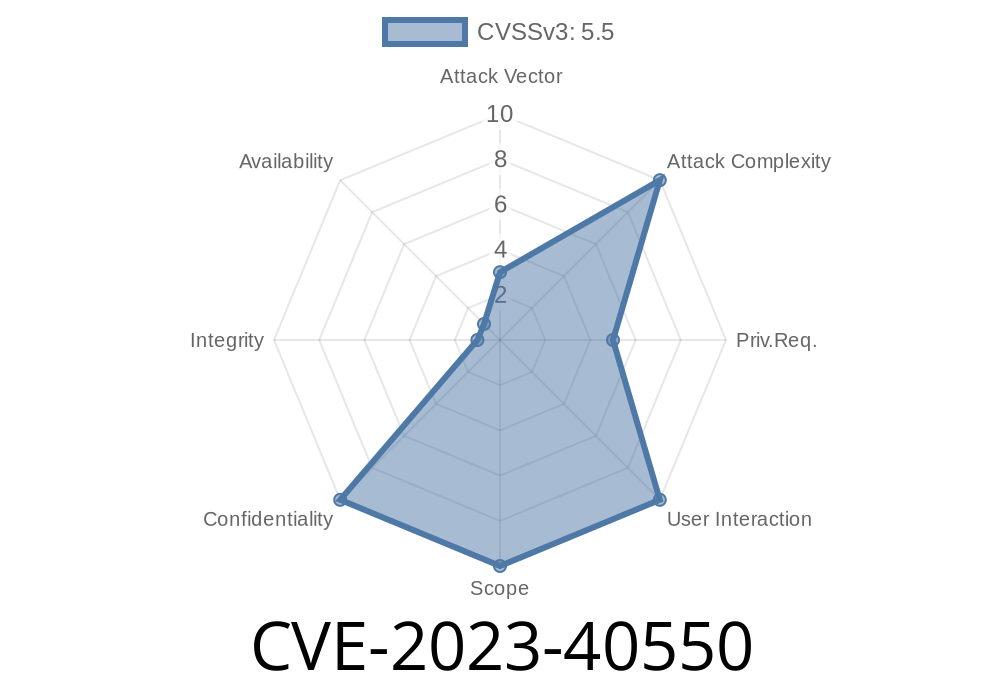CVE-2023-40550 - Out-of-Bounds Read Flaw in Shim when Validating SBAT Information: Risks and Mitigation Strategies

Security researchers have identified a critical out-of-bounds read vulnerability in Shim, a widely used software component that enables the boot of the Unified Extensible Firmware Interface (UEFI) of a Linux OS. The vulnerability, assigned as CVE-2023-40550, poses a serious risk to systems that rely on Shim for booting. In this long read, we will examine the details of this exploit, its potential impact, and the recommended steps to mitigate this issue.
The Vulnerability - Out-of-Bounds Read
The flaw was discovered in the portion of Shim responsible for validating the Secure Boot Advanced Targeting (SBAT) data, a security feature that helps prevent against privilege escalation attacks during boot. Specifically, when Shim attempts to verify the SBAT information, it may trigger an out-of-bounds read, potentially exposing sensitive data during the system's boot phase.
Here's an example of a code snippet, showcasing where the vulnerability might manifest
void verify_sbat_data(struct image *image) {
struct sbat_data sbat = {};
size_t size;
uint8_t *data = pe_image_section(image, ".sbat", &size);
if (!data) {
/* No SBAT data found - do nothing */
return;
}
/* Vulnerable out-of-bounds read occurs here */
memcpy(&sbat, data, sizeof(sbat));
/* Validate the SBAT information */
validate_sbat_entries(&sbat);
}
In the code snippet above, Shim reads the SBAT data from the .sbat section of the PE image without proper boundary checks. As a result, it may happen that Shim accidentally reads more data than anticipated, consequently leaking sensitive information to system memory.
Relevant Sources and Exploit Details
The out-of-bounds read vulnerability in Shim is tracked in the Common Vulnerabilities and Exposures (CVE) as CVE-2023-40550. The complete technical details of this flaw are documented in the following original references:
1. Shim source code repository
2. UEFI Secure Boot Advanced Targeting (SBAT)
3. Linux kernel mailing list discussion on the vulnerability
The exploit details are as follows
- A successful exploitation of this vulnerability may expose sensitive data, such as cryptographic keys, passwords, or other private information, during the system's boot phase.
- Attackers must have either physical access to the target system or the ability to influence the boot image to exploit this vulnerability. In many scenarios, this is a limiting factor.
- Systems using the vulnerable version of Shim are at risk. This includes many Linux distributions that have enabled UEFI Secure Boot.
Mitigation Strategies and Recommendations
To address the out-of-bounds read flaw in Shim, administrators and users are advised to take the following steps:
1. Keep an eye on relevant security advisories and check for updates from the respective Linux distribution and Shim maintainers. A fix for this issue is expected to be released soon.
2. Upgrade to the latest available version of Shim once it becomes available. This will ensure the flaw is patched, and users are protected.
3. In the meantime, consider disabling UEFI Secure Boot on affected systems or using an alternative boot program, such as a GRUB2 bootloader.
Conclusion
The discovery of CVE-2023-40550 highlights the importance of maintaining a secure boot process and the continued efforts of security researchers to identify and remediate vulnerabilities in essential system components. By staying up-to-date with the latest security bulletins, patches, and best practices, users can minimize the risk of exposing sensitive data during the boot phase.
Timeline
Published on: 01/29/2024 17:15:08 UTC
Last modified on: 04/29/2024 14:15:07 UTC